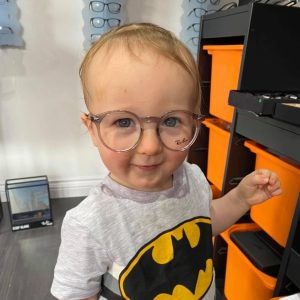Someone told me….
You may have heard all sorts of things about what is good and bad for your eyes…
But are they true?
Here we present you with the facts about these 20 common eye myths:
Basic Biology
Myth 1. All babies are born with blue eyes.
When babies are born, their eyes may sometimes appear blue while their melanin is still developing. Within about 12 months, cells begin to produce melanin. As more melanin builds up in the iris, eye colour may darken.
Myth 2. Babies are born with their eyes fully grown.
Generally, babies are born with eyes that are approximately two-thirds of their full adult size. Eyes continue to grow after birth, usually during two phases: 1) the first few years of life, and 2) puberty.
Myth 3. Two brown-eyed parents can’t have a blue-eyed child.
The truth is, you can’t predict a child’s eye colours from the parents’ eye colours at all. Current research suggests that as many as 16 different genes could be responsible for eye colour. That’s why two parents with the same eye colour can have a child with entirely different eye colours.
Vision Improvement
Myth 4. Eating carrots will improve your vision.
Vitamin A is essential for the body to maintain healthy eyesight and carrots have high amounts of this nutrient. But the body only needs a relatively small amount of vitamin A for vision, and it can be obtained through many sources such as dark, leafy greens, brightly coloured vegetables, dairy, and fish. While eating foods rich in vitamin A can help you maintain good eyesight, it won’t improve your vision or keep you from needing glasses or contacts. Remember to eat vitamin A-rich foods and fat to absorb the benefits better. Having said that, if you tell your kids this is true as a means of getting them to eat their veg, we’ll 100% back you up 😉
Myth 5. You can improve your vision with eye exercises.
Eye exercises will not improve or preserve vision or reduce the need for glasses. Your vision depends on many factors, none of which can be significantly altered with eye exercises.
However, eye exercises may be helpful for convergence insufficiency, a condition that occurs when the eyes don’t work together to focus on a nearby object, making it difficult to read.
Myth 6. Sun gazing—or, looking directly at the sun—can improve your health and well-being.
Staring at the sun for even a short time without wearing the right eye protection can permanently damage your retina and cause blindness. Ordinary sunglasses and homemade filters are not safe for looking at the sun. The only safe way to look directly at the sun is through special-purpose solar filters that meet the CSN EN ISO 12312-2 standard.
Vision Impairment
Myth 7. If you cross your eyes, they’ll stay that way.
Your eye muscles allow you to move your eyes in all directions. Looking left or right, up or down, won’t force them to remain in those positions, just as crossing the eyes won’t force them to stay that way. Crossed eyes may result from disease, uncorrected vision, or from muscle or nerve damage.
Myth 8. Only boys can be colour blind.
Women can develop or inherit colour blindness, but men are at much higher risk. An estimated 1 in 12 males have some form of colour deficiency. Most colour blind individuals are born with a partial or complete lack of cones in the retina, which help distinguish the colours red, green and blue. Less frequently, colour vision problems can occur later in life as the result of disease, trauma, or toxic effects from drugs that damage the retina or optic nerve.
Myth 9. People who are colour blind see in black and white.
Most people who are colour blind see partial colour. The most severe form of colour blindness, in which everything is seen in shades of grey, is uncommon. Most people with colour blindness have difficulty distinguishing between greens and reds.
Myth 10. Sitting very close to the TV can damage your eyes.
While sitting very close to the television may cause eye strain or give you a headache, it will not damage vision in children or adults. However, habitually sitting close to the television may signal that the person is nearsighted and, in fact, needs glasses. Children have a heightened ability to focus on nearby objects, so they might find it more comfortable to sit close to the TV.
Myth 11. Reading in dim light is harmful to your eyes.
It does not harm your eyes to read in dim light. But good lighting can make it easier to see what you are reading and keep your eyes from tiring out more quickly.
Myth 12. Using computers can damage your eyes.
Looking at a computer screen will not harm your eyes, but doing so without breaks can contribute to eye strain, tired eyes, or dry eyes. Be sure to rest your eyes every 20 minutes by looking up or across the room. Blink regularly to keep your eyes well lubricated and use artificial tears to promote moisture.
Myth 13. People who wear glasses will ruin their eyes if they read the fine print or do a lot of close-up work.
Reading and detail work do not wear out the eyes. But they can strain your eyes, making them tired. Taking periodic rests by gazing into the distance or looking up can help provide relief.
Myth 14. Wearing eyeglasses or contact lenses will make you dependent on them.
Using your glasses won’t worsen your vision or lead to any eye disease. If you need glasses for distance or reading, it is important to use them to avoid straining your eyes and to ensure your best vision possible.
Myth 15. Wearing the wrong eyeglasses will hurt your eyes.
Wearing glasses with the incorrect prescription will not damage your eyes, but it may strain them, cause achiness or blurriness, or give you a headache. This should go away when you take the glasses off.
Myth 16. I can see fine, I don’t need an eye test
Eye tests are more than just about the health of your eye. An eye test can also lead to early detection of various health issues that may be affecting you such as – Aneurysm, brain tumour, cancers of blood, tissue or skin, diabetes, iant cell arteritis, high blood pressure, high cholesterol, lupus, Lyme disease, medication toxicities, multiple sclerosis, myasthenia gravis, rheumatoid arthritis, sarcoidosis, sexually transmitted diseases, sickle cell disease, Sjögren’s syndrome, stroke, thyroid disease, vascular disease, Vitamin A deficiency
Myth 17. Losing vision is an inevitable part of ageing.
Many vision problems that develop as people age can be treated. Presbyopia, which is near-vision loss, and cataracts can both be remedied to allow adults to see clearly again. It is recommended that most people should get their eyes tested every 2 years to catch both reversible and permanent threats to vision, such as glaucoma or macular degeneration. Oftentimes, early treatment can slow or prevent vision loss.
Myth 18. A cataract must be ‘ripe’ before it is removed.
A cataract can be removed as soon as it compromises your vision. Thanks to modern advances in cataract surgery, the lens can now be removed from the eye as soon as it’s cloudy enough to make reading fine print or street signs difficult.
Myth 19. Eyes can be transplanted.
It is not possible today to transplant a whole eye because this complex organ is connected to your brain by the optic nerve. The optic nerve is made up of more than 1 million tiny nerve fibres. Once these nerve fibres are cut, they cannot be reconnected. However, ophthalmologists can transplant the cornea, which is the clear front part of your eye.
Vision Professionals
Myth 20. All eye doctors are the same.
Ophthalmologists, optometrists, and opticians each play an important role in eye care. But their levels of training and expertise are quite different from each other.
Ophthalmologists (eye surgeons) are doctors that specialise in the medical and surgical care of the eyes and visual system. They also look into the prevention of eye disease and injury. An ophthalmologist treats people of all ages, from premature babies to the elderly. Conditions dealt with in ophthalmology can include eye trauma, cataracts, diabetic eye conditions such as diabetic retinopathy, as well as congenital and genetic eye problems.
An optometrist is trained to recognise abnormalities in your eyes. They examine the internal and external structure of your eyes to detect conditions such as glaucoma, macular degeneration and cataracts. They may also test your ability to focus and coordinate your eyes and see depth and colours accurately. If necessary, the optometrist will refer you to your GP or a hospital eye clinic for further investigations. Optometrists can prescribe and fit glasses, contact lenses and low vision aids, and, if trained to do so, medicines to treat eye conditions.
Dispensing opticians fit glasses and contact lenses working from the prescriptions written by an ophthalmic practitioner or ophthalmologist. They also fit and dispense low vision aids such as magnifying glasses or telescopic spectacles. They do not do eye tests. A dispensing optician can give you advice on types of lenses and help you to choose frames and other optical aids. They can also give you advice about wearing and caring for your glasses or contact lenses.



